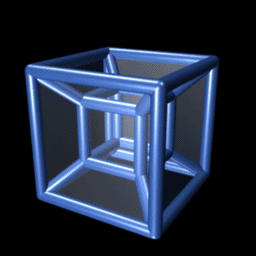4th Dimensional Leadership
OVER THE YEARS, I’ve worked in the energy sector with scientists who taught me how to perceive what was invisible to the naked eye. To predict hydrocarbon reservoirs or mineral reserves buried deep in the Earth’s crust, geologists and geophysicists are trained in the science and the art of perceiving.

MEET ED, A GEOLOGIST WHO SEES IN 4-D
In the 1990s, most of the science guys (and then, they were mostly guys) I worked with were strait-laced, buttoned-up and fairly conservative. There was one geologist, named Ed, who stood out from the crowd—a long-haired hippy type from southeast England. With his wide bell-bottom pants, platform boots, thick silver chains and chunky rings, Ed looked like he’d stumbled off the tour bus of the Rolling Stones and landed from outer space onto the Canadian prairies.
Ed was an exotic in the western Canadian oil patch, and even more than his appearance, he had a gravelly voice that made your head whip around to see who was talking. It wasn’t just the tone of his voice that was different, it was how he spoke; the cadence was different, and long pauses punctuated his thoughts. Then, people in the oil industry spoke in the crisp, decisive language of science and here was Ed, speaking in swirling sentences that ended with questions and in a language that went well beyond the tangible.
Ed and I worked together on several projects, but I recall one new venture in particular—a project in Algeria—that left me spellbound. Sitting side-by-side on a plane en route from Paris to Algiers, Ed took the time to explain the geology behind a particular exploration play our company was targeting. His narrative brought the oil and gas reserves in the ground to life—not in the language of 3-D seismic and 2-D rock samples or one-dimensional lines on the maps. Rather, Ed described how he perceived the reservoir as a two-winged butterfly.
Through his scientific lens, Ed could fairly logically delineate oil reserves in the shape of a one-winged butterfly. Through intuition (or however you want to explain the 4th dimension he was accessing), Ed sensed reserves in the shape of the butterfly’s second wing. He was willing to stake his reputation on the likelihood of that two-winged butterfly-shaped reservoir being discoverable, in the depths of the Saharan desert.
What was remarkable to me then, and still, is Ed’s level of confidence in that sensing. He had been proven prescient in other projects—including enormously risky (and enormously successful) exploration plays in the country of Yemen. Fiercely logical accountants and engineers trusted Ed’s judgement and discernment, even if they couldn’t fully grasp his jump from logic to intuition. And so did I.
PERCEIVING THE WORLD IN MULTI-DIMENSIONS
Geologists and geophysicists are skilled at layering on dimensions to discover hydrocarbon reserves buried deep in the Earth. One-dimensional lines on a map delineate surface anomalies and hint at what resources lie below the surface. With the addition of the second dimension—depth—rock faces and exposed sedimentary layers can be scrutinized for more clues. Accessing the third dimension can be even more powerful; in particular, in their search for hydrocarbons, geologists and geophysicists often use 3D seismic, a highly technical process, to help conceptualize formations buried deep underground.
And, there are exceptional geologists and geophysicists who have figured out how to use intuition to access the fourth dimension. These are the people who can see around corners. How do they do it?
THE FOURTH DIMENSION
Mathematicians and physicists have been playing with this idea of the 4th dimension for centuries. Genius physicist, Albert Einstein, fused the dimension of time into the three dimensions of space, creating “spacetime.” Marvel Comic super-heroes routinely add another dimension; for example, Spiderman, once bitten by a radioactive spider, learns to detect danger with a “Spidey-sense”. Indigenous shamans access Nature to open up different ways of knowing.
Most of us would not self-identify as a super-hero, genius physicist or shaman. But many of us are curious about how we can access this 4th dimension. Some “ordinary” people have a powerful sense of empathy; they sense what’s going on around them when it’s not obvious in the one-two-or-three dimensional world. Science is learning more, helping to explain, for example, why 1-2% of the human population are super-recognizers—people with an uncanny ability to memorize and recall faces, even after the briefest glimpse. Psychedelic drugs like LSD and magic mushrooms are making a comeback—their use is increasingly destigmatized, even regulated. These cracks in the rules have been opened for the chronically ill but talk to anyone attracted to their use; accessing another dimension is the allure.
We know other people are doing this. And most of us want to know how we too can gain these 4-D superpowers.
BUILDING 4-D LEADERSHIP CAPACITIES
What if we told you that leaders can improve their capacity to bring 4-D leadership to their enterprise? Don’t worry; we’re not recommending some flakey, New-Age, drug-induced, flavour-of-the-month leadership tactic! Do be wary of charismatic “soul”-preneurs and spiritual healers selling you self-realization programs and personal success platforms in psychedelic packaging. The 4th dimension is not accessible via narcissism or consumerism. What we’re encouraging is intentionally honing your capacity to access a fourth dimension, and upping your leadership game.
If you have ever acted on an instinctive feeling or a hunch, in spite of tangible data in front of you, then you are already working in this dimension. Do you recognize when something is niggling at your subconscious, telling you to take a pause or make a choice that doesn’t line up squarely with the hard facts? Do you listen to that intuitive message?
The most effective leaders do this all the time.
Of course, decisions are often rationalized and explained in the language of reason and logic, but some highly effective leaders are not only influenced by the tangible. They give themselves permission to access another dimension. In his book, Blink: The Power of Thinking Without Thinking, Malcolm Gladwell explores how our brains use two very different strategies to make sense of a situation. The first is logical and definitive; the second strategy operates—at least at first—below the surface of our consciousness. Gladwell acknowledges that people are “innately suspicious of this kind of rapid cognition,” the sense of intuitive knowing, and prefer to rely on scientific data. But there are times when we should trust our instincts, and there are ways to educate and control these non-rational perceptions.
Here’s how it can work, for you.
As leader of an enterprise, you no doubt bring many core leadership skills to the table. You know how to assess risk, make tough decisions, design and implement strategies, align people, and develop other people. If you can’t bring these skills to the table, you aren’t in the leadership game.
Leaders who are able to break away from the pack are also able to bring additional skills to their enterprise, including the ability to imagine. To use your imagination necessitates being able to step beyond what is present to the physical senses. The capacity to originate an idea, a concept, a vision for a preferred future, beyond the norm, is a step into the fourth dimension.
A few exceptional leaders have upped their leadership capabilities even further, and are positioned to lead when the pathway ahead isn’t clear or obvious. These leaders demonstrate the capacity to wonder and to allow for emerging ideas. What can this look like? It’s being open to ambiguity and “not knowing”, holding space for new thinking or better ideas to arise. It’s deep, continuous curiosity and an insatiable quest for discovery. It’s the experience of wonder beyond cause and effect thinking.
As a leader, you can permit yourself to move beyond one-two-and-three dimensional modalities of perception and access your intuitive 4th dimension.
The pathway to shoring up these capacities—and trust and confidence in higher-order leadership qualities—is unique for each leader. It requires the deepest level of self-mastery to be in tune with that 4th dimension of perceiving, and the starting point is intention.
These abilities can be cultivated. Some people choose to hone these qualities through Nature, music and sound, rituals, art, culture, creativity, mindfulness, meditation, prayer, faith, or any other intimate practice that can take your leadership to a higher-order aesthetic. Identify leaders you know who pay attention to, and trust, these 4th dimension qualities, and invite them to share their stories.
It took me hours of listening to understand how Ed, the geologist with seemingly extrasensory insight, could stack up one-two-three and four-dimensional thinking in his pursuit of hydrocarbon reserves. What Ed shared resonated deeply, and gave me confidence that, with practice, I could do the same.
Link to original blog - guest post: takeitpersonelly.com
